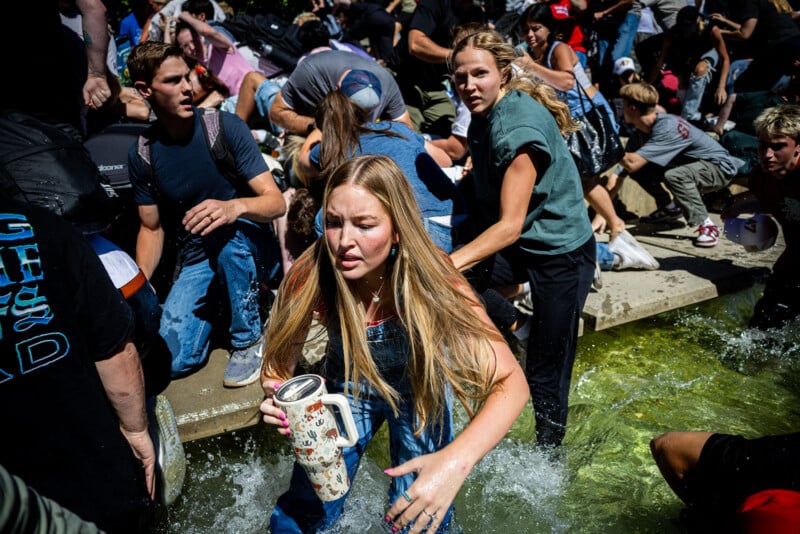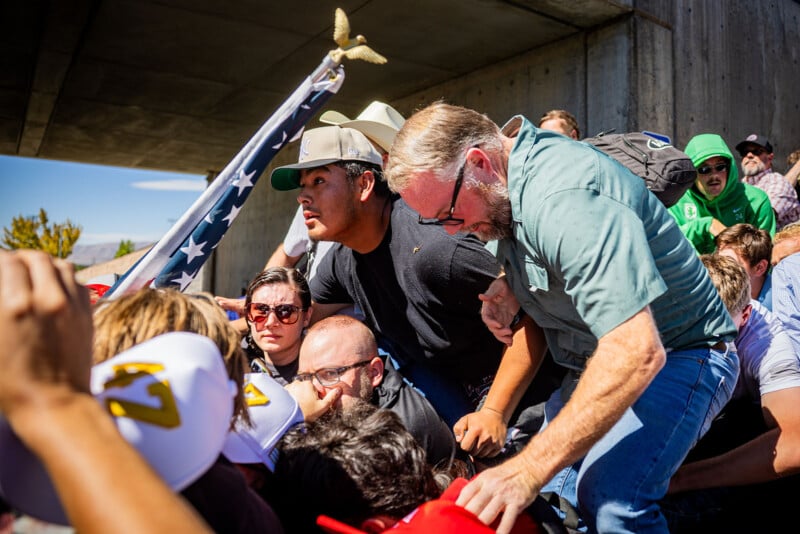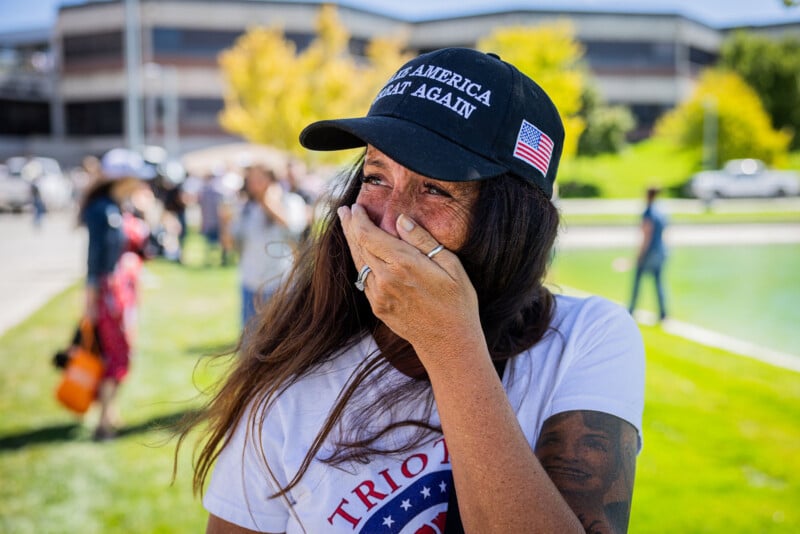After Charlie Kirk Was Shot, a Young Press Photographer Kept Her Cool

A young press photographer who was covering Charlie Kirk’s appearance at Utah Valley University when he was assassinated tells PetaPixel how she was able to remain calm and capture dramatic photos that have been published all across the world.
Tess Crowley, who works for Salt Lake City-based Deseret News, has only been a staff photographer since April. When she received the assignment to cover Kirk’s appearance at UVU, it was just another speaking event, the kind she had covered numerous times already.
But what unfolded last Wednesday was one of the most shocking acts of political violence in American history as thousands in attendance witnessed Kirk’s murder, and gruesome videos of it were beamed around the world to millions in the moments after.
The 23-year-old photographer was not only there to cover the event itself but also to capture plenty of stock photos of the right-wing provocateur for future articles.
“I took photos of Kirk throwing hats to the crowd and their reactions to seeing him. The atmosphere was full of excitement,” Crowley tells PetaPixel over email.
“Because there were no designated spots for the press, and I had managed to get as close as I could get, I didn’t want to move from my spot. I stayed there, even though it was incredibly crowded.”

Expecting the speaking event to unfold as usual, Crowley began taking photos of Kirk, as well as capturing images of the debaters and the crowd. But at 12:23 PM, approximately 10 minutes after he had begun speaking, Kirk was killed by a gunshot fired from a campus roof opposite the stage.
“I didn’t even register what I had heard,” Crowley says. “I was swept down to the ground with the crowd. Everyone ducked within seconds of the shot. On the ground, I realized the noise that I had heard was a gunshot, which meant that this was a shooting.”
Crowley says she felt “shock and fear” and was afraid of what could happen next. “Would more shots be fired? Where did the shot come from? I, thankfully, didn’t see Kirk get shot,” she adds.

Seconds after the gunshot had rang out, Crowley picked up her cameras and started documenting.
“People were screaming, crying, running, and ducking. It was chaos. I was next to a man and a woman lying on the ground. The man was covering her body and face with his body and hands. He was yelling at everyone to stay down as he protected her. I took photos of them. I stayed down for a bit, taking photos of the people who had started running away,” the photographer recalls.
“Once more people started to get up, I did too. I ran with them and ran into a man being handcuffed by the police, who was later cleared and released. I followed him and the police to the police car near the fountain behind the tent Charlie Kirk had been speaking in when he was shot.”
“I started documenting everyone gathered on the lawn by the fountain,” she continues. “People were crying and holding each other. I was shaking and could barely speak. At this point, I tried to ask a couple of people their names for captions. I approached two people I thought were mother and daughter holding each other. They were crying, and I started crying too. I asked them about their relationship to each other, and they told me that they were complete strangers.”

Crowley’s photos are sharp, well-composed, and impactful. PetaPixel asked her how she was able to hold her nerve in such a terrifying and chaotic situation.
“Everything happened so fast. The photos I took of people fleeing during the immediate aftermath of the shooting were taken within the span of about five minutes,” she explains.
“As I was photographing, my hands were shaking and it was difficult to breathe. But the act of taking photos was second nature to me. I take pictures every single day. I think that for me, picking up the camera felt like a reflex. I think I was feeling the physical effects of fear in that moment, with the shakiness and the tears, but mentally, I felt sharp.”

Crowley says she remembered how to do her job but felt frustrated in the moment because she felt her camera was “lagging” while taking photos.
“I thought it was just my shaky hands or a weird, undiagnosed camera problem. I realized while photographing another press conference that my camera was in single-shot mode the whole time. During it all, I had no time to diagnose or even think about the problem. I just had to keep photographing.”
Afterward, Crowley checked in on her Deseret News reporter colleagues who were hiding underneath desks in a building nearby.
“I called the other news photographer there, Trent Nelson from the Salt Lake Tribune, when I saw that he had texted me asking if I was OK,” Crowley says.
“I walked back to the scene of the shooting in the courtyard and found him getting overview shots of law enforcement descending upon the scene. It felt good to see a familiar face.”
After documenting police putting up tape, Crowley left to wire her photos to her editor from her car. She came back to the scene and saw fellow Deseret News photographer Laura Seitz, overwhelmed with emotion; the pair hugged.
Crowley’s photos were syndicated via Associated Press and wound up on the front pages of local, national, and international newspapers.
“I’m feeling overwhelmed, and a bit numb,” Crowley reflects. “I have been too busy with work to really let it all sink in. I’ve had a tremendous amount of thoughtful messages come in from family, friends, strangers, and co-workers.”

Crowley only moved to Salt Lake City in January from Michigan to be a photo intern at Deseret News and has since been hired full-time. She previously interned at the Chicago Tribune and The Virginian-Pilot.
More of Crowley’s work can be found on her website and Instagram.
Image credits: Tess Crowley / Deseret News